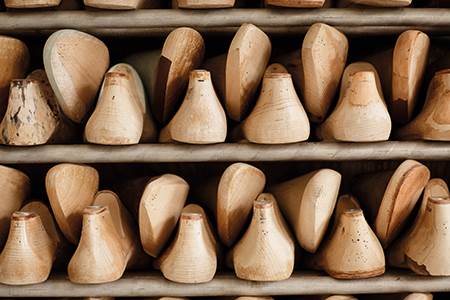How last shape can influence fit

Do you often think about your feet during the day? If the answer is ‘yes’, your shoes probably do not fit properly.
The fact that you do think about them probably also means you are experiencing discomfort which is undesirable. Forcing your feet further back in your shoes because your bunions are sore, taking them off to give yourself a quick rub over the arch or developing calluses or blisters are all symptoms of poorly fitting footwear.
The problem is not limited to demographic groups based on race or geographic location alone. Nor is it necessarily the fault of fashion. It is actually quite simple and, while the solutions are more complex, they nonetheless exist and can be implemented more easily than one might think. The two most prevalent and widespread causes are the shapes and sizes of the lasts footwear is made on. The quest for universally well-fitting footwear is of course the ultimate aim, but it can never happen with 100% success.
To begin with, the foot changes shape and size during the course of the day. Depending on a person’s bodily makeup, daily routine, climatic and other factors, feet can expand in girth up to two sizes during that period. So, regardless of how pliable the shoe is or how closely the last matches the foot in question, it is totally unrealistic to expect a relatively static object like a shoe to keep up with the dynamics of the human foot from early morning to last thing at night. Then there is the wide variety of foot shapes that exist in the world, let alone the fact that no individual has two feet that are identical in shape and size. Anyone marketing footwear globally has to cope with variations such as a wide forefoot, a narrow heel, a high instep, low arches, high arches as well as other anatomical anomalies.
There was a time when we thought we could associate shape demographics with geographical regions. However, increased inter-racial marriage and continental population shifts have drastically weakened any theories that certain regions of a country or the world have people with a specific foot shape. The last bastions of this ideology are probably Asia or Africa, where feet are certainly proportionally wider than in those areas that have traditionally been more widely industrialised.
Western boot lasts
As individual feet change in shape and size, so there are huge variances in any given market. However, the problem with fit starts well before these factors come into play. With very rare exceptions, today’s last shapes are geared more towards efficient production than even a generic attempt at good fit. Basic measurements may be within ‘industry standards’ but what about shape? There was a time in the mass production of shoes when lasts were shaped more like the typical human foot. However, in an effort to simplify pattern engineering and increase manufacturing productivity, lasts have adopted the nearly symmetrical shapes we see today.
Evidence of the benefits of properly shaped lasts does still exist, even in today’s mass production. Western boots, for example, are a fashion item that comes and goes but never entirely disappears. However, many mass market styles are made on lasts that traditional boot makers would never use and the resulting poor fit means they are soon discarded as too uncomfortable. Anyone who has ever worn a true Western boot that has been properly made on a classic last knows it can be the most comfortable and supportive footwear you will ever wear. The reason is simple...the last shape.
Classic Western boot lasts are not shaped to facilitate pattern engineering or to speed up production. To begin with the forefoot curves towards the medial (inside) side more than does a typical shoe last. The cone also slants to this side as it runs forward from the instep to the ball and the bottom radius is usually slightly off centre, again towards the medial side. Backparts are much more sculptured than even some ladies pump lasts, heel widths are narrower and measurements are much tighter in the ball and vamp area.
All this is designed to make the boot fit the foot and prevent it sliding forward or the heel slipping. The short heel measurement is properly proportioned to the rest of the foot so that when the boot is pulled on, the foot almost ‘pops’ into it. This sometimes requires a boot puller to make it easier to exit the boot but that is a minor inconvenience when you have had them on all day and never thought about your feet because they didn’t hurt. This is the way all footwear should feel.
Getting into the swing
No one would ever suggest that last shapes should be available in the mass market to fit every person precisely. That is simply not feasible except in custom made to measure footwear. Even then, there remains the challenge of the foot swelling during the course of the day. However, a handful of last categories that addressed the main foot types would go a long way towards eliminating many of the more common problems people face when trying to purchase shoes off the shelf.
Lasts with narrow heels, high and low arches and high insteps would help, but perhaps the most important factor is the alignment or ‘swing’ of the foot. Stand up and look down at your feet without shoes on. Some people may actually see very little medial slant to the upper bones of the feet and the pronation of their feet might be so slight as to make the foot appear to be straight or, in rare cases, even supinated towards the outside. But these cases would not be the norm. A typical foot will indeed have the look and alignment of a classic Western boot last. (Supination means that when walking, body weight tends to be on the outside of the foot. Pronation means it tends to be on the inside).
A different approach
So, what could be done to make a given shoe fit as many people in as many countries as possible and, using different grading systems? Today’s computer technology is capable of offering consumers a much wider choice when purchasing footwear. However, rather than simply offering many sizes and numerous widths, as has been the traditional approach, it might be better to limit those parameters and instead go for foot types.
The dark perimeter line in Figure 1, is the feather edge of the last and the two straight blue ones show ball tread and heel width. By grouping lasts according to key points such as foot angle, ball tread angle, heel width angle and the location of the centre of gravity, greater success in terms of fit can be achieved. Simply grading a range of sizes and widths often fails to take into account the bone structure or biometrics of the foot. The value of producing only two or three widths within the same basic size ranges but with options of narrow heels and several different degrees of pronation could substantially increase the number of potential customers able to buy shoes that were a good fit.
The same layout as shown in Figure 1 can be applied to foot groups based on a range of angles and centre of gravity locations. Four of five foot groups in these categories would provide a much more logical basis for fit than merely making shoes wider or narrower while still trying to force the foot into a shape that is not suitable. In Figure 2, the dark grey perimeter lines indicate the actual bottom surface of the foot (including toes) where it would touch the floor in a standing, barefoot position. Ball tread and heel width are shown as before but in orange. The green line is the widest volume point of the top of the foot and would correspond to the upper of the last at its widest point.
For instance, a base last shape could have several alternate shapes that could be quickly created and the process of converting the existing shoe style to the new last shapes would be but a fraction of the original design and pattern engineering process. True, there would be additional inventory of pieces and, depending on the manufacturing process, perhaps dies and some moulds. However, the effort and expense would result in far happier customers with far happier feet.
* This feature is based on an article by Bill Tippit Snr. that appeared in an earlier issue of World Footwear.












